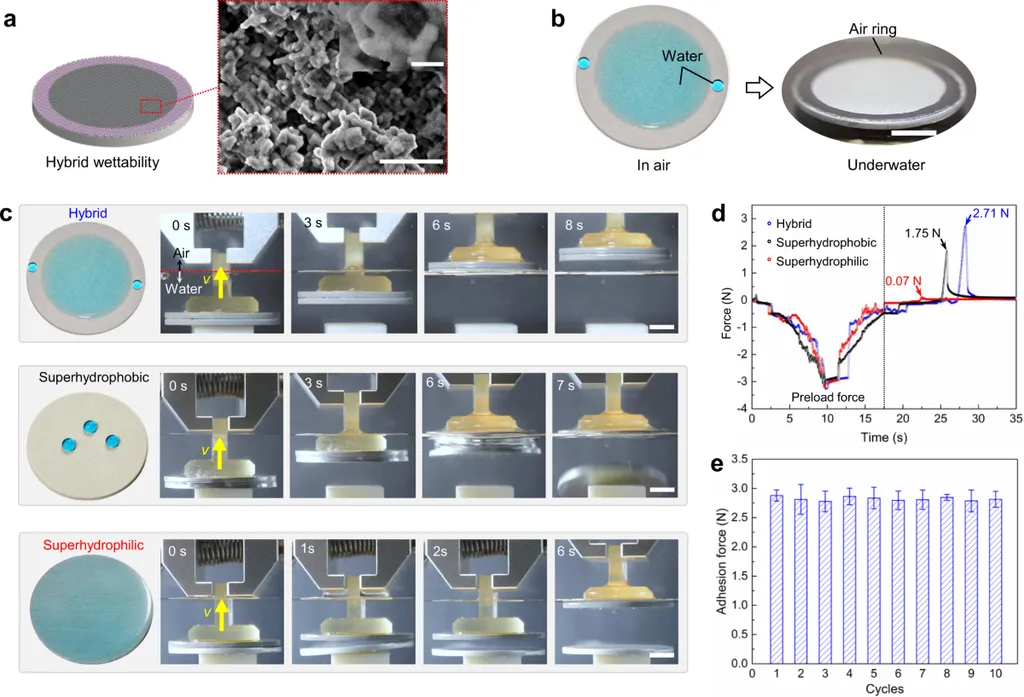In the quest to design more efficient and effective hydrophobic surfaces, researchers have long relied on wettability as a key indicator. However, a new study published in *Macromolecular Materials and Engineering* (or, in English, *Macromolecular Materials and Engineering*) suggests that water adhesion—a property often overlooked—might hold the key to unlocking new possibilities, particularly in the energy sector. The research, led by Gabriele Livi of the School of Engineering at the University of Edinburgh, delves into the intricate relationship between water adhesion and wettability, offering insights that could revolutionize how we approach surface design.
Water adhesion, distinct from wettability, refers to the force required to remove a water droplet from a surface. While wettability measures how well a liquid spreads on a surface, water adhesion focuses on the normal force needed to detach the droplet. This distinction is crucial, especially in applications where surfaces must repel water efficiently, such as in heat exchange systems, agricultural coatings, and biomedical devices.
Livi and his team investigated the water adhesion properties of hydrophobic electrospun fibers made from polycaprolactone (PCL) and varying concentrations of poly(lactide-co-caprolactone) (PLCL). Using a micromechanical balance, they conducted experiments to observe how water droplets spread and withdrew from these surfaces. Their findings revealed a strong correlation between contact angle hysteresis—the difference between the advancing and receding contact angles—and the maximum adhesion force. This challenges previous assumptions that maximum adhesion is primarily linked to receding contact angles.
“Our study highlights the importance of considering water adhesion separately from wettability,” Livi explained. “We found that for fibrous hydrophobic surfaces, contact angle hysteresis is a more reliable indicator of adhesion forces than previously thought. This could have significant implications for designing surfaces that are both hydrophobic and highly adhesive.”
The implications for the energy sector are particularly compelling. Efficient heat exchange systems, for instance, rely on surfaces that can quickly shed water to maintain optimal performance. Understanding and controlling water adhesion could lead to the development of more effective coatings that enhance heat transfer and reduce energy consumption. Similarly, in agricultural applications, coatings that repel water more effectively could improve the longevity and performance of equipment and structures exposed to harsh environmental conditions.
The study also suggests that adhesion tensiometry—a method for measuring the force required to detach a droplet—could be a more robust and accessible approach for characterizing water adhesion on fibrous hydrophobic surfaces. This could simplify the process of evaluating and optimizing surface properties, making it easier for industries to adopt these advancements.
As the energy sector continues to seek innovative solutions for efficiency and sustainability, this research offers a fresh perspective on how surface science can play a pivotal role. By focusing on water adhesion, researchers and engineers can develop materials that are not only hydrophobic but also tailored to specific adhesion requirements, ultimately driving progress in various applications.
Livi’s work underscores the importance of interdisciplinary collaboration and the need for continued exploration in the field of surface science. As we move forward, the insights gained from this study could pave the way for groundbreaking advancements, shaping the future of energy, agriculture, and beyond.

